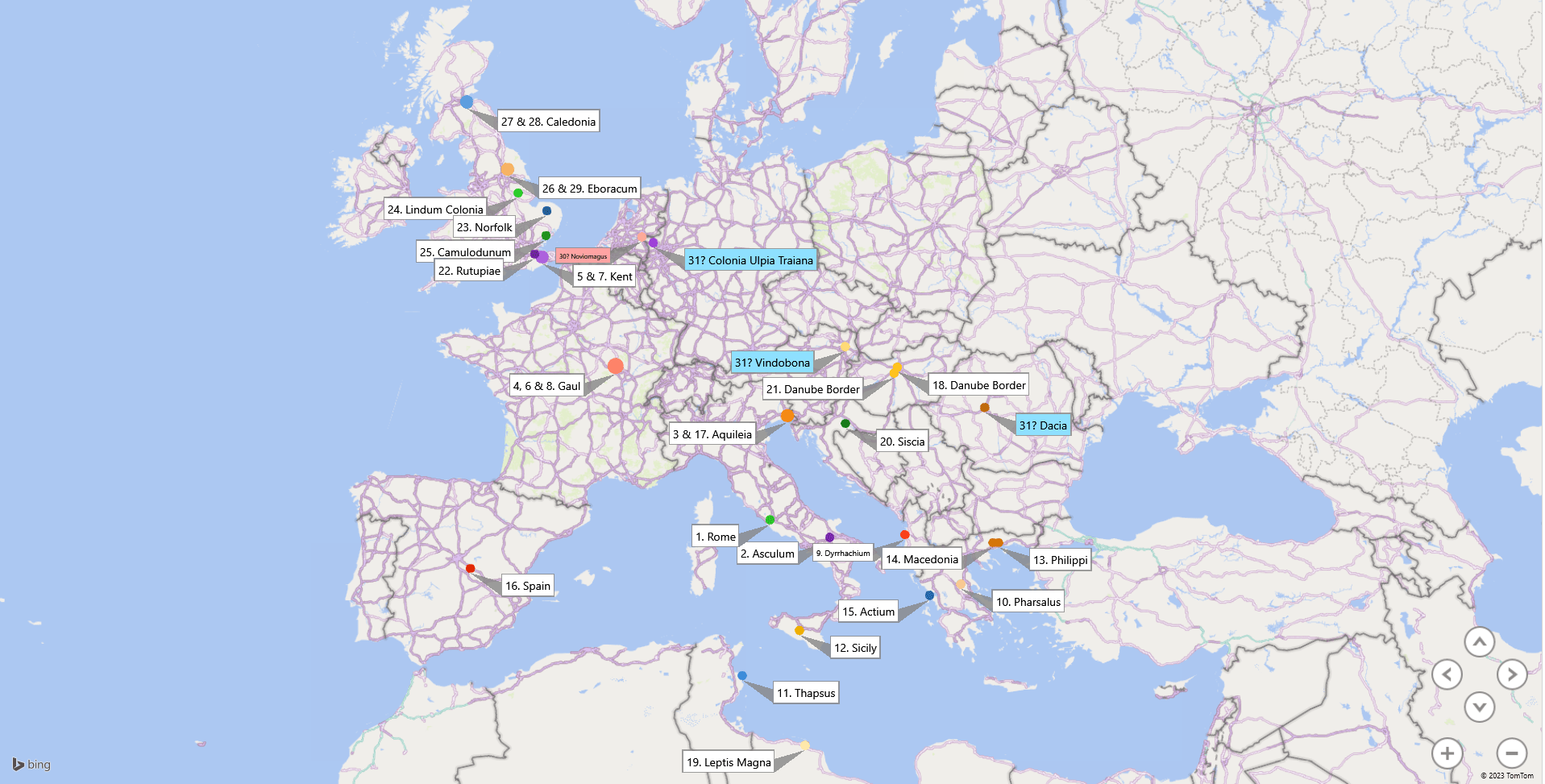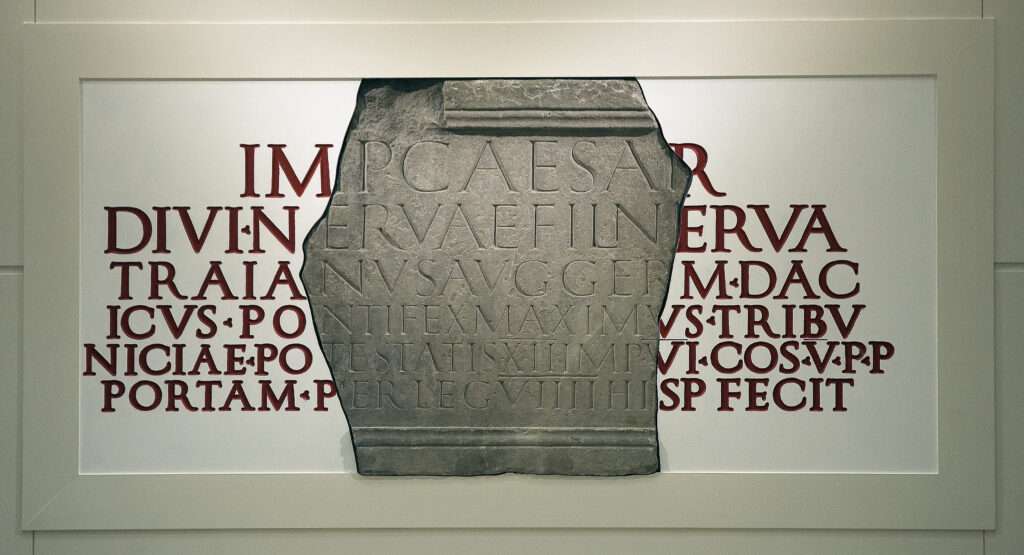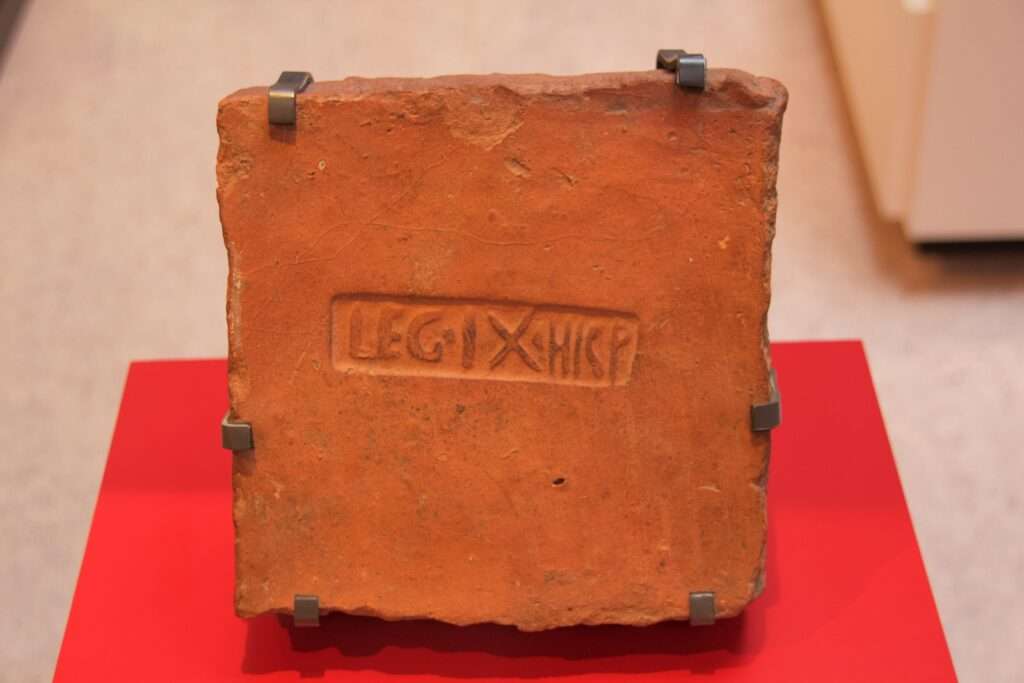It is one of the most significant historical mysteries – what happened to Rome’s ninth Legion? Was it destroyed in Britannia? Judea? Armenia? Or is there another explanation? Here, we will trace the movements of the storied Roman Legion, cover the popular theories, and add to the conversation by formulating our own theory about the fate of the Legio IX Hispana.
The Ninth Legion has a colorful history, first being levied early in the first century BC. It appears to have participated in the Social War in 90 BC.
It was active under Julius Caesar when he took over as governor of Cisalpine Gaul. He took the Ninth Legion and five other legions with him to fight the various Gallic tribes in his Gallic Wars.
The Ninth Legion also fought for Caesar during the civil war between him and Pompey the Great. After the Civil War, Caesar disbanded the Legion. He gave his veterans land, and they settled in northeast Italy.
The Ninth was then reconstituted by Octavian, with many veterans and evocati fighting under the future emperor Augustus in the civil war against Mark Antony.
Augustus then sent the Legion to Hispania as he campaigned against local tribes there in the mid-20s BC. This likely is where the Legion got their nickname ‘Hispana’.
It made several movements around the empire before participating in the Roman invasion of Britannia under emperor Claudius in AD 43.
It had some early victories in Britannia but also suffered a significant defeat at the Battle of Camulodunum during the revolt of Boudica in AD 61.
The Legion then traveled north after replenishing their numbers, where they built a fortress at Eboracum (York).
It took part in the invasion of Caledonia (Scotland) almost two decades after the disaster at Camulodunum. They suffered a similar fate, suffering heavy losses after a surprise nighttime attack from the local tribes.
The Ninth eventually returned to Eboracum, with the last recorded activity in Britannia being AD 108.
Tracking the ninth

- The Legion is levied early in the first century BC.
- It took part in the Social War in 90 BC.
- Based in Aquileia, it then travels with Julius Caesar to Gaul, initiating the Gallic War
- Caesar conquers different parts of Gaul.
- Caesar and his legions cross into Britannia in 55 BC
- Legions return to Gaul.
- Caesar crosses over to Britannia again in 54 BC.
- Legions return to Gaul.
- Civil War sees the Legion accompany Caesar to Greece and Macedonia where they take on Pompey at Dyrrhachium in 48 BC.
- Battle of Pharsalus 48 BC.
- Legion is sent to Thapsus for an African campaign 46 BC. Caesar disbands legion afterwards.
- Octavian recalls veterans, while evocati troops would no doubt be present. The Legion was reinstated to put down the rebellion of Sextus Pompeius in Sicily.
- Participates in the Battle of Philippi in the Civil War against the armies of Mark Antony in 42 BC.
- Legion is sent to Macedonia.
- Legion take part in Battle of Actium against Mark Antony 31 BC.
- Legion travels to Hispania to help the now-emperor Augustus conquer the rest of the Iberian Peninsula. This is where the Legion likely picked up its moniker ‘Hispana’.
- Legion returns to Aquileia in 10 BC.
- Legion is posted to the Danube border region in AD 14.
- Ninth legion sent to Africa to quell a rebellion by the Numidians in AD 20.
- Legion is sent to Siscia (Sisek, Croatia) in AD 22.
- Legion returns to Danube border.
- The Ninth legion accompanies emperor Claudius in his invasion of Britannia in AD 43.
- Legion moves north and sets up an outpost in modern-day Norfolk AD 44.
- Legion moves further north and builds a fortress in modern-day Lincoln in the late AD 40s.
- Legion takes part in the Battle of Camulodunum (Colchester) in AD 60, suffering heavy losses.
- Legion is sent further north and builds a legionary fort at Eboracum (York).
- Legion is sent to the far north and is almost destroyed by a surprise attack by the Caledonians in AD 82.
- Legion takes part in the Battle of Mons Grapius against the Caledonians in modern-day Scotland in AD 83.
- Legion returns to fort at Eboracum. The last record we have of the Ninth Legion in Britannia is AD 108.
- (red highlight) Archeological evidence has surfaced that at least part of the Ninth Legion was stationed at Noviomagus Batavorum (Nijmegen, Netherlands). The evidence is dated between AD 104 and AD 120. The evidence shows that a detachment of the Ninth Legion was posted there. However we do not know if the whole Legion was posted there.
- (blue highlight) Possible location of soldiers from the Ninth Legion.
Thanks to archeologist and historian Simon Elliott, I was able to piece together some of the missing information regarding the movements of the Ninth Legion.
Check out his summary here of what he thinks happened to the Legion and how he came to this conclusion. It is an excellent summation and examines the evidence well.
What happened after AD 108?
Things start to get murky after AD 108.
There doesn’t seem to be any record of the ninth Legion in Britannia after AD 108. There is no record of them fighting and no record of them building anything. Hadrian’s Wall was constructed in the early AD 120s. However, there are no inscriptions or evidence of them assisting with the construction effort, despite the Legion building a fortress in Lindum Colonia (Lincoln) and Eboracum (York).

By Photographed by: York Museums Trust Staff – This file has been provided by York Museums Trust as part of a GLAMwiki partnership. Commons:Licensing., CC BY-SA 4.0
However, some evidence has been discovered at an old Roman legionary fort in Noviomagus Batavorum in Germania Inferior (modern-day Nijmegen, Netherlands).
Tiles have been found with an inscription that is said to bear the Legion’s name Leg VIIII (nine was sometimes written like this) on it. It also has the abbreviation ‘Vex Brit’ on it. This is said to be short for ‘vexillatio Britannia’. A ‘vexillatio’ is a “detachment” from a particular legion that has been sent to perform duties elsewhere. This is quite a common occurrence.
This is interesting because the tiles are dated between AD 104 and AD 120. If the dating is correct, this could prove that parts of the Legion existed past the last recorded activity in Britannia in AD 108.
Popular theories – Destruction in Britannia
The most popular theory is that the Caledonians destroyed the Legion while campaigning in Scotland. Much of this stems from the fact that the Ninth Legion was almost wiped out by Caledonians while campaigning there and is the main reason for the construction of Hadrian’s Wall.
Further evidence that may corroborate this story is an exchange, which can be found in The Correspondence of Marcus Cornelius Fronto, between scholar Marcus Cornelius Fronto and Marcus Aurelius (whom Fronto previously tutored) in the AD 160s.
When writing to Marcus Aurelius about the Parthian War, Fronto talks about the Gods turning the fortunes of war back into the Romans’ favor; he writes:
“But Mars has spoken of the Romans in the same strain many a time and in many a war: in the Gaulish war at Allia, in the Samnite at Caudium, in the Punic at Cannae, in the Spanish at Numantia, in the Jugurthine at Cirta, in the Parthian at Carrhae. But always and everywhere, he turned our sorrows into successes and our terrors into triumphs.
But not to hark back too far into ancient times, I will take instances from your own family. Was not a consular taken prisoner in Dacia under the leadership and auspices of your great-grandfather Trajan? Was not a consular likewise slain by the Parthians in Mesopotamia? Again, under the rule of your grandfather Hadrian, what a number of soldiers were killed by the Jews, what a number by the Britons!”
It is the last line about the Britons killing many soldiers under the reign of emperor Hadrian that has helped reinforce this theory. Emperor Hadrian became emperor in AD 117, so the Romans killed by the Britons would have to be killed sometime around AD 117 or later. This rules out the earlier attacks by the Caledonians in AD 82.
The loss of a significant number of Roman soldiers (possibly the ninth Legion) under Hadrian could have sparked his need to construct a wall. However, evidence of a substantial conflict has so far not been forthcoming. But who is to say that evidence is not out there and that it just hasn’t been discovered?
It is also important to note that when Hadrian’s Wallwas built in AD 122, there was no mention of the Ninth Legion helping to construct it, despite them being stationed nearby at Eboracum for over 40 years prior and building the legionary fort there.
Had the Legion been destroyed by that point, or had they been moved on?
Destruction in Judea
Another theory suggests that the ninth Legion left Nijmegen sometime between AD 120 and AD 130 and took part in suppressing a Jewish revolt in Judea in AD 132.
The theory goes that it was destroyed during the revolt, along with another Roman legion – Legio XXII Deiotariana. The Twenty-Second Legion was based in Egypt; the last records date it to around AD 120.
It must be noted that occasionally, the emperor inscribed lists of active legions. A list of active legions that Marcus Aurelius released during his reign did not include either of these legions. This was also confirmed in a list written by Cassius Dio in Book LV, XXIII-XXIV of his Roman History book.
If these two legions were destroyed in the Jewish revolt, this would mark one of the worst defeats in Roman History.
Destruction in Armenia
This theory suggests that the ninth Legion was sent to the Middle East during the reign of Marcus Aurelius for his Parthian campaign of AD 161 – AD 166.
It is suggested that the Legion perished at the hands of the Parthians in Armenia. This is supported by an excerpt from Cassius Dio’s Roman History, Book LXXI, II:
“Vologaesus, it seems, had begun the war by hemming in on all sides the Roman legion under Severianus that was stationed at Elegeia, a place in Armenia, and then shooting down and destroying the whole force, leaders and all”.
However, there is little evidence of the ninth being in the Middle East.

By Photograph by Mike Peel (www.mikepeel.net)., CC BY-SA 4.0
Another theory
I have been thinking about this for some time, reviewing some of the evidence, and developing my own theory.
A weakened Legio IX Hispana was sent to Noviomagus Batavorum in Germania Inferior early in the reign of Hadrian, where it was disbanded, and the troops merged with one, or possibly three, other legions.
The first piece of evidence is the letter from Marcus Cornelius Fronto to Marcus Aurelius about many Romans being killed by the Britons. This could have led to the remainder of the Legion being taken off the front line and sent elsewhere. The evidence found in Noviomagus Batavorum (if it does date to AD 120 as claimed) suggests they could have been sent there.
The Legio VI Victrix was also sent to Britannia to replace the Ninth Legion at Eboracum. The Sixth Legion, along with the Second Augusta and the Twentieth Valeria Victrix, were all involved in building Hadrian’s Wall in AD 122, with no mention of the Ninth.
The Sixth Victrix was based in Germania Inferior before being called to Britannia so that it could have been a straight swap with the weakened Ninth Legion.
In his Roman History, Cassius Dio lists the active legions (his listing of the I, II & III Parthica legions dates this list from AD 197 onwards, as these legions were levied in AD 197).
In Book LV, XXIII, he lists all the legions, with the IX Hispana missing. After that, he does mention something interesting:
“These are the legions that still remain out of those of Augustus; of the rest, some were disbanded altogether, and others were merged with various legions by Augustus himself and by other emperors, in consequence of which such legions have come to bear the name Gemina.”
This is very interesting. It basically says that all other legions that are not listed were either disbanded or merged under the name Gemina. There are five legions with the moniker ‘Gemina’ – the twin tenth legions, the thirteenth, the fourteenth, and a later formed seventh legion.
The Seventh Legion was based in Hispania; one of the twin Tenth Legions was based in Judea, while the other twin Tenth Legion, along with the Fourteenth, was based in Vindobona (Vienna, Austria). The thirteenth was based in Dacia (Romania) after the Dacian Wars.
The Tenth Gemina was based in Hispania in AD 68-69 before being sent to quell the Batavian rebellion in AD 70. They were stationed at the fort in Noviomagus until AD 103 before being moved to Pannonia. It stayed there until the fifth century AD.
The next bit of evidence is the life of a Lucius Aemilius Carus (or Karus). He served as a military tribune in the Ninth Legion. According to Duncan Campbell:
“Lucius Aemilius Karus (a variant spelling of Carus). This former tribune of the Ninth Legion was governing the praetorian province of Arabia in AD 142, the task of a man in his mid- to late thirties”.
If he was in his mid-to-late thirties in AD 142, that puts his birth somewhere around AD 100 at the earliest. This means he would have served in the Legion early in Hadrian’s reign (after AD 117).
He also notes that another soldier, Lucius Novius Crispinus Martialis Saturninus, served in the ninth Legion and eventually became consul in AD 150. He was likely born around AD 105. This puts his service in the ninth Legion to some time in the AD 120s.
Lucius Carus also spent time leading the Legio XXX Ulpia Victrix. This Legion was levied in AD 100 by emperor Trajan for his Dacian Wars. They were sent to Colonia Ulpia Traiana (Xanten, Germany) in AD 122. This is in the same province where the Ninth was stationed.
There is no evidence that the Legion was destroyed in Britannia or anywhere else, nor do the ancient sources explicitly mention the fate of the ninth. If a legion were destroyed, it would be written about, like those that were destroyed at Teutoburg Forest. Even if the Legion were disgraced, it would be mentioned somewhere in the primary sources.
However, suppose it was just a simple merge with other legions. In that case, that isn’t as noteworthy to write about as legions were regularly reinforced by soldiers from other legions.
Conclusion
My overall theory is that the Ninth Legion was weakened by fighting in Britannia. It switched with the Sixth Victrix legion, with the Sixth going to Britannia and the Ninth heading to Noviomagus. The Legion was then disbanded sometime in the AD 120s and merged with the Tenth Gemina in Pannonia, along the Danube, while some may have merged with the Fourteenth Gemina in Dacia to reinforce the newly conquered territory. Some may have followed Lucius Aemilius Carus into the Thirtieth Ulpia Victrix.
Much of this is based on circumstantial evidence. Still, some of the timelines of these legions are pretty close, while the Gemina legions were on the front line in Trajan’s wars in Dacia. Battle-weary legions need reinforcements, and it makes sense to consolidate the armies by disbanding an already weakened legion to reinforce others. Cassius Dio’s comments about merging legions and those legions being called Gemina make sense in this regard.
Sources:
The fate of the Ninth – Duncan Campbell
Roman Britain’s Lost Ninth Legion Simon Elliott
Cassius Dio Roman History Book LXXI (Thayer) – (Public Domain)
Cassius Dio Roman History Book LV (Thayer) – (Public Domain)
The Correspondence of Marcus Cornelius Fronto – tranlated by C Haines – (Public Domain)

